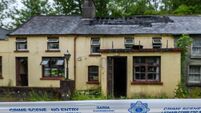Celtic Tiger’s remains - Economy still haunted by excess
The plethora of ghost estates is a legacy of appalling disregard for even the most rudimentary rules of planning by local authorities infected by the madness of greedy bankers who gave out vast loans to gluttonous developers, the bulk of which will never be repaid.
Across the country, they are grim reminders of what can happen when political leaders ignore the warning calls of those who shout stop. Intoxicated by Ireland’s flawed image as the fastest growing economy in Europe, bankers, developers, and politicians were blind to the folly of putting all their eggs in one basket.
While the position has improved somewhat compared with the scandalous spectacle of over 2,000 ghost estates blighting the landscape, a new report says 1,770 unfinished housing developments have yet to be resolved. Exposed to the weather and cordoned off by razor wire in the interests of public safety, over 1,100 of these estates are in what Housing and Planning Minister Jan O’Sullivan described as “seriously problematic condition”.
Her aim is to salvage as many estates as possible but she concedes that some are “commercially unviable”. The fact many will have to be demolished because of the poor build quality and lack of demand for homes in those areas is further proof of the profligate waste of the past decade and the insanity of building concrete towns and villages in virgin countryside where none were needed.
As a journey through Ireland will illustrate, the worst areas are the Midlands and Border regions, places where houses, shops, and office blocks appeared at a bewildering rate, springing up overnight on the promise of rich rewards. While 296 developments were resolved in the past year, the question is how many more will be salvaged and put to beneficial use after next spring, the minister’s deadline for a plan to be in place.
If anything, the latest data on mortgage arrears from the Central Bank is more alarming than the ghost estate debacle. Financial institutions lent €32bn to landlords and 29% of arrears in the buy-to-let sector are now more than three months behind. This compares with a 14.7% arrears rate for owner-occupied properties.
As the State’s financial authority, the Central Bank’s clear message to the commercial banks is to tackle distressed debt in a more efficient and structured way. Obviously, the banks were unmoved by last month’s scathing criticism from Fiona Muldoon, the Central Bank’s head of banking regulation.
Challenging tight-fisted bankers to be more constructive, she wondered whether they were hoping the mortgage crisis would be solved by an economic recovery or an increase in house prices, equally unlikely scenarios. Depicting them as being “in denial”, Ms Muldoon accused bankers of behaving like teenagers, an apt description. If the banks fail to act on mortgages, the repercussions for tens of thousands of people in Ireland will be utterly disastrous.













